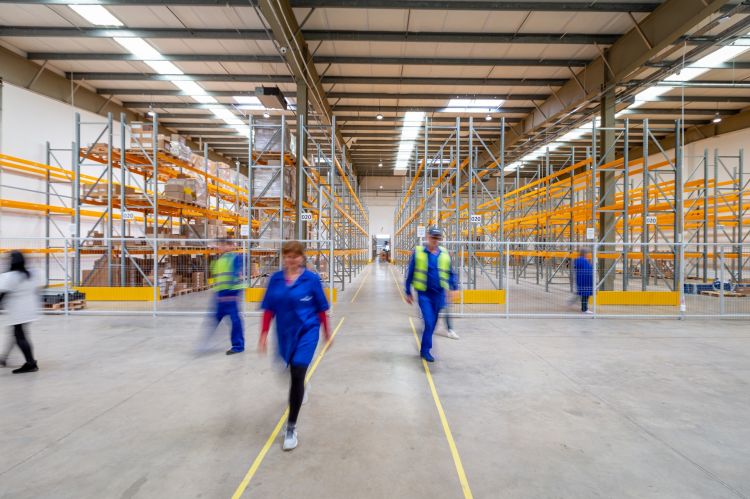How IoT Can Vastly Improve Warehouse Management
Almost no one would argue against the idea that Amazon has been the face of innovation in the supply chain and warehouse management field. From the ecommerce giant’s use of an automated robot army, like Kiva smart shelves and order-packing machines, to its intelligent and voice-enabled picking system, efficiency is the name of the game. Unfortunately, it gives the impression that many competitors, especially small-time operations, cannot hope to compete in the space.
But that idea is wrong. With the help of modern technologies, namely the Internet of Things (IoT), it’s possible to vastly improve warehouse management and achieve unprecedented levels of efficiency. IoT can streamline inventory management, and improve nearly every application or process within the average warehouse — leading to the revolutionary smart warehouses of tomorrow. Reports show that global IoT in warehouse management is expected to grow in market value to $17.93 billion by 2025, with a CAGR of 21.21%.
Dealing with Talent Shortages
There’s a labor shortage affecting the entire supply chain, let alone most logistics operations, and it shows in the average warehouse. Without a sudden and massive influx of new talent and manual labor, something must be done to offset the deficit. Enter stage left, IoT, advanced robotics — or cobots — and data-driven solutions. They can empower levels of automation in the warehouse like we’ve never before seen, even beyond what Amazon is capable of currently.
More importantly, the same technologies can help train and empower new candidates, as well. It takes about 60 hours to fully train an employee, but smart technologies — like smart glasses, AR, and voice-driven guidance systems — can reduce that number to 41.2 hours per employee. At the heart of it all is IoT, and many smart sensors that collect, process, and report operational data for smarter and contextual decision-making.
Enhanced Asset Management
Whether you’re talking about equipment like personal protective gear or a forklift, to the inventory and pallets full of goods, asset management is a critical aspect of warehouse management. IoT can significantly enhance this process, by allowing faster allocation of equipment and goods, and also in the organization of the various systems. Radio-frequency identification tags, or RFID, can be used to track assets as they move about a warehouse, including off of the property.
Tagging, categorizing, organizing, picking, shipping, and just about any other process related to warehouse management becomes much simpler when the related assets can be located, at any time, and a moment’s notice. It also empowers high-level automation, as robots and machines can follow the data to locate, pick, and deal with various goods.
In fact, IoT-driven and smart asset management systems have been proven to deliver a 10% to 14% time savings boost to warehouse operations.
Reduced Theft, Fraud, and Damages
Directly related to asset tracking and smarter inventory management, it’s easier to see what’s going on with goods as they ship to a warehouse, when they arrive, while they’re stored, and then as they move out. That includes before, during, and after they exchange hands between internal teams and partners, vendors, or suppliers. What does that mean?
It’s possible to identify, track, and deal with a variety of problems that would have gone largely unnoticed in the past — before these smart technologies. Theft and fraud can be identified early, and fast, and then dealt with before the operation incurs any major damages. The same is true for damaged or altered goods, which are affected by various logistics processes.
Identifying where items are being damaged or stolen, means it’s much easier to take action and remedy such problems. This is especially evident in frozen or cold-storage items, such as food and medicine. According to the UN Food and Agriculture Organization, about one-third of all foods perish in transit or 1.3 billion tons of edible food. Detecting where those foods are going bad, what is the cause, and how to fix them is imperative not just to reduce costs but also to preserve the health and safety of consumers.
Data-Driven Management
Supply chain planning and warehouse management have always been about data, or rather they’ve always been data-driven. In the past, however, that data was not as efficient or accessible. Paper logs and huge document files, for example, are a lot less simple to scour or examine. Not to mention, with paper, there’s no way to tap into more advanced technologies like data analytics, or machine learning and AI.
IoT, smart technologies, and digital solutions all come together to create a more accurate, more powerful, and much more efficient process. It’s not even just about making things faster through digital adoption. Machine learning and neural network tools can dig into ingested data and discern trends, patterns, and other outcomes that would have never been visible to the naked eye. They are inherently creating new opportunities and scenarios, merely through the effective exploration and processing of existing information.
Machine learning can be used in management processes to improve facility and worker safety, empower customer support, reduce operational waste, organize inventory and assets, and much much more.
How IoT and Smart Technologies Are Applied to Warehouse Management
Some off-the-cuff examples of IoT and data-driven processes within the warehouse include end-to-end inventory tracking, smarter asset management, precise and speedy picking, automated tasking, including the empowerment of advanced robotics, and, of course, data-driven management applications.
But these are just a handful of examples, in a field where the sky's the limit. Smart sensors collecting real-time data can legitimize so many different tasks, processes, and applications, it’s difficult to imagine a world where they don’t exist, or they’re not in use.
One thing is apparent above all. Logistics and warehouse teams that do not leverage IoT and smart technologies, whether big or small ops, cannot hope to compete in the industry, especially against the giants like Amazon and beyond.

